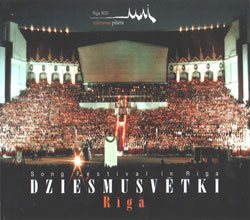
Latvians are more likely to ask each other “Did you go to the last Song Festival?” rather than “Have you ever been to one?” Almost every year for decades, a song festival has been held somewhere in the world, and Latvians have flocked in droves to this most ubiquitous celebration of their culture and heritage. Non-Latvians may have difficulty understanding the excitement and emotion surrounding these events. Lasting several days to a week or more, the larger festivals feature numerous concerts, dance presentations, crafts exhibitions, nightly balls, and mass demonstrations of Latvian patriotism and nationalism—in short, total immersion in the Latvian ethos.
During the period of Soviet occupation of Latvia, festivals were held periodically in Latvia, but the repertoire and events were carefully manipulated. While the trappings of Latvian culture were present (at least those reasonably acceptable to Soviet authorities), many foreign influences were also felt and much was strictly proscribed. During those years, festivals in Latvian communities abroad helped keep the spirit alive, and when Latvians were finally allowed to hold a truly national festival in their own country in 1990, for the first time in 50 years, the excitement, pageantry, emotion, and sense of occasion were overwhelming.
The album Dziesmusvētki Rīgā features some highlights from that milestone event, as well as more recent selections. Issued as part of the national commemoration of the 800th anniversary of the founding of Latvia’s capital, Rīga, this compact disc mixes old favorites with some novelties.
The disc opens with choral arrangements, by Jānis Cimze, Emīlis Melngailis and Pāvuls Jurjāns, of beloved Latvian folksongs. Original compositions by Jāzeps Vītols (“Gaismas pils”) and Raimonds Pauls (“Manai dzimtenei”) follow, works that have come to be as well known to most Latvians as their national anthem.
The Festival Choir has numbered up to 24,000 singers in Rīga, and the ability to cohesively and musically conduct such a huge mass of singers with subtlety and nuance is clearly an art form. Effectively recording such a widely dispersed field of humanity, where balance problems are already inevitable when one end of the choir is hundreds of feet away from the other, is also a highly specialized skill, with happier results in some selections than others.
All the conductors represented here are experienced in directing such large forces, though some are more satisfying than others. Haralds Mednis’ performance of “Gaismas pils” is a model of clarity, unity, and musicality. On the other hand, Jānis Zirnis succumbs to the temptation to stretch phrases to their limits and overemphasize dramatic effects in Melngailis’ “Jāņu vakars.” Subtlety is not really the point of these events, though: for the singer, it’s the joy of lending one’s voice under such momentous circumstances; for the listener, it’s the thrill of hearing a huge, stirring sound.
Two purely instrumental works follow: an old waltz tune, “Brūklenājs,” zips along merrily but the ensemble often verges on chaos. A potpourri of popular Latvian beer-drinking songs, arranged for brass band as “Alutiņš,” chugs along in marching-band style of a century ago. A 1998 choral composition by Juris Vaivods titled “Rīgas dziesmas” concludes the more traditional fare on this disc, and features a number of familiar tunes with connections to Rīga’s past. Effectively done, and enthusiastically sung.
Finally, something completely different—excerpts from Zigmārs Liepiņš’ rock musical “Teika,” presented at a Latvian youth song festival held in 2000. Despite generally not being fond of rock music, I found parts of the work very enjoyable and arresting. This is not a work with a strong, personal profile, though—much of the material is firmly rooted in the sound of groups and composers popular in the 1970s in the West, such as Supertramp and Electric Light Orchestra, and Imants Kalniņš’ influence is also felt. I suspect this work would have been much more interesting on video—the excitement of the audience and photos in the booklet suggest a strong visual element.
The album has attractive packaging, with thorough annotations in Latvian and English. Proofreading by a native English speaker would have been useful, though. In short, if you’d like a souvenir of “Rīga 800” and a melange of different musical genres doesn’t discourage you, then by all means try this unique, generally enjoyable compilation.
Details
Dziesmusvētki Rīgā
Various artists
MICREC and Latvijas Radio, 2001
MRCD 158
© 1995-2024 Latvians Online
Please contact us for editorial queries, or for permission to republish material. Disclaimer: The content of Web sites to which Latvians Online provides links does not necessarily reflect the opinion of Latvians Online, its staff or its sponsors.




